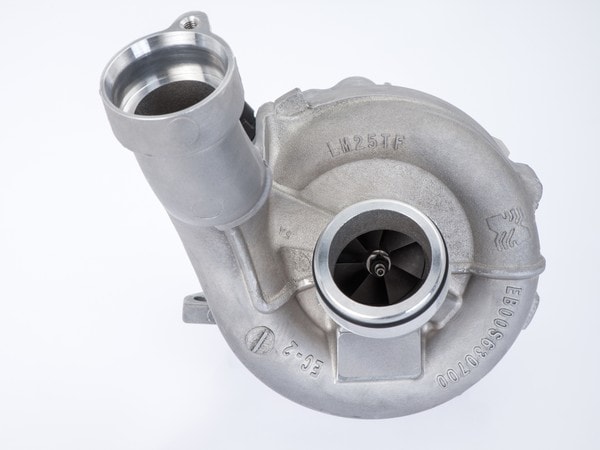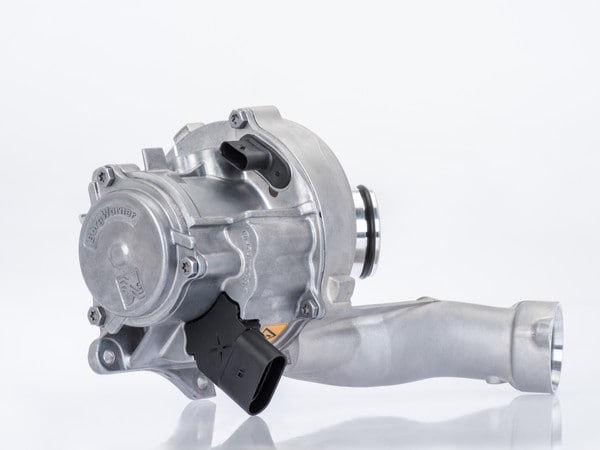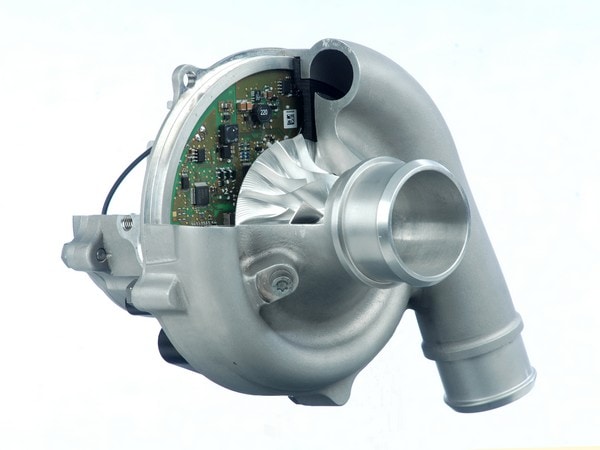
The concept of pumping more air into an internal combustion engine to burn more fuel to produce more power is nearly as old as the engine itself. It is typically (and increasingly in recent years) done by an exhaust-driven turbocharger, which uses the substantial heat energy in exhaust gases exiting the cylinders to spin a turbine that drives a pump that pushes more intake air into them. The other alternative has been a supercharger driven by the engine.
Each of these performance-enhancing systems has advantages and disadvantages, but the most noticeable difference is that the typical turbocharger takes a bit more time to spool up (resulting in “turbo lag”) as engine rpm, and the resultant exhaust heat and pressure, increase after you step on the go pedal. A supercharger, which is mechanically linked to the engine, increases boost more quickly in direct proportion to engine speed. But now there is a third alternative: an electrically driven supercharger-like compressor that supplier BorgWarner calls an eBooster.
“Our market-leading eBooster technology enables 6-cylinder engines to deliver the same performance and even more fun-to-drive experience as a much larger conventional V-8,” said Frédéric Lissalde, President and General Manager, BorgWarner Turbo Systems. “By enabling engine downsizing, eBooster technology improves fuel efficiency by 5 to 10 percent in combustion and hybrid vehicles.”
Supplement to traditional turbos
BorgWarner says its motor-driven eBooster “delivers boost on demand until the turbocharger takes over, improving boost at low engine speeds and nearly eliminating turbo lag.” It will debut in combination with a BorgWarner turbocharger on a 2018 Mercedes-Benz 3.0-liter gasoline V6 and will also soon be available from at least two other global automakers.
It could also help a turbocharged four perform like a six, but would it make sense on a naturally aspirated engine without a turbo? “We have had discussions with various companies regarding use of an eBooster by itself, when a naturally aspirated engine just wants a little extra kick at low engine speeds,” says Brock Fraser, BorgWarner’s innovation and new concepts director. “But the trend is eBooster with turbocharger to span the whole rpm range.
Fraser asserts that it helps “a lot” at low rpm and in transients (like passing on a two-lane) by kicking in instantly before the turbocharger is up to speed, then handing off to the turbo. They are normally arranged in series so intake air flows first through the turbocharger compressor, then through the eBooster compressor. At some point in the rpm range, the eBooster runs out of flow capacity and motor power and is phased out. A bypass valve opens to send the air around it instead of through it. “And the transition is very smooth,” he says.
Fraser adds that an eBooster can be especially useful on a smaller-than-normal engine or a larger-than-normal turbo. “One way to improve fuel economy is to downsize the engine,” he says. “But as we downsize, we have worse low-end and transient torque. So the eBooster’s immediate boost on demand can give more low-end torque and quicker transient response than you would otherwise have. And with a larger-than-normal turbo for more top-end power, it can also improve fuel efficiency because, when you’re cruising at very light engine load, not using the turbocharger, a larger turbo has less flow restriction that a smaller one.”
Also: Class of 2018 – New Cars Ready to Roll
Cost-benefit ratio high
How significant is the cost of adding an eBooster to a turbocharged engine? “A lot of companies are finding it worth paying for,” Fraser says. “When you consider the alternatives to improve both performance and fuel economy, this emerges as a good value solution.” Much less complex and expensive than adding an engine-driven supercharger (like on Volvo’s Drive E), we would think, because a supercharger needs a more expensive belt drive and a clutch to turn it on and off, among other things. “A supercharger is also really tough to package in the premium space around the belt drive,” Fraser says, “it’s not as controllable, and it is engine-speed dependent, not as instantaneous or as energy efficient.”
An eBooster also enjoys the advantage of being self-contained. The motor, compressor, power electronics and DC (battery) to AC (motor) converter are all in one compact unit. “So people are leaning toward electrified solutions and away from mechanically coupled solutions.”
One potential disadvantage is that the eBooster runs on 48-volt power. But Fraser points out that more and more modern vehicles will already have 48-volt (in addition to traditional 12-volt) systems to run other high-power components. “I don’t know of any applications that will add a 48-volt system only for an eBooster,” he says. “They will have that infrastructure on the car and may use it to run active body control, the AC compressor, power steering and various other systems, including an eBooster.” The trend toward more dual-voltage vehicles, with 48-volt batteries added to run higher-power systems, is driven by increasing accessory content in modern vehicles and because converting mechanically driven pumps and devices into on-demand electrically operated components improves fuel efficiency.
Fuel economy gains
Besides providing instant power boost to improve the performance response of any vehicle, conventional or hybrid, BorgWarner claims that adding an eBooster also can improve fuel economy. “The eBooster by itself doesn’t change the fuel economy of an engine,” Fraser explains. “Rather, it enables changes to the engine that unlock fuel economy improvement. For example, we built a Ford Mustang with an eBooster added to its a 2.3L EcoBoost turbocharged four-cylinder engine, then compared that prototype to its 5.0 L V8 counterpart. Our eBoosted Mustang outperforms the V-8 Mustang in every respect—much more low-end torque, much more midrange torque, much more top-end power—along with up to 35 percent better fuel economy. That illustrates what can happen with engine downsizing.”
Beyond the announced Mercedes-Benz 3.0L V-6 and two other near-term applications, BorgWarner sees substantial growth for its eBooster technology. And Fraser says potential customers for it include automakers from the U.S. and Asia as well as Europe. We’ll eagerly look forward to driving that 2018 eBoosted Mercedes V6, and others as they arrive.









